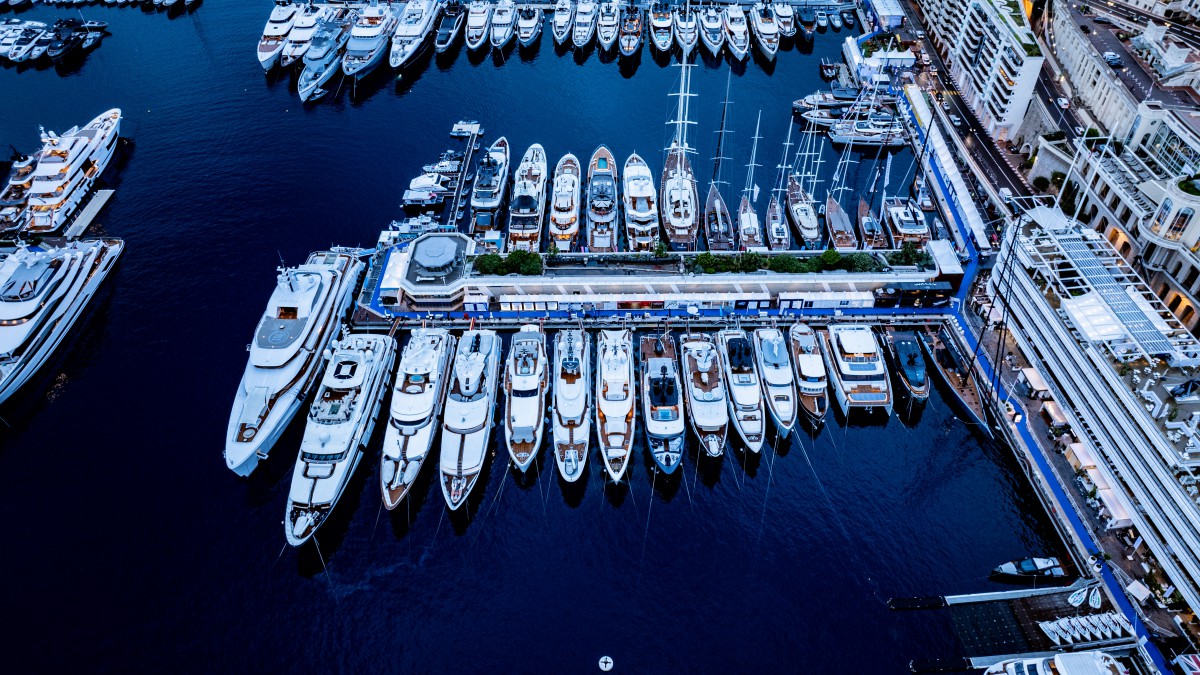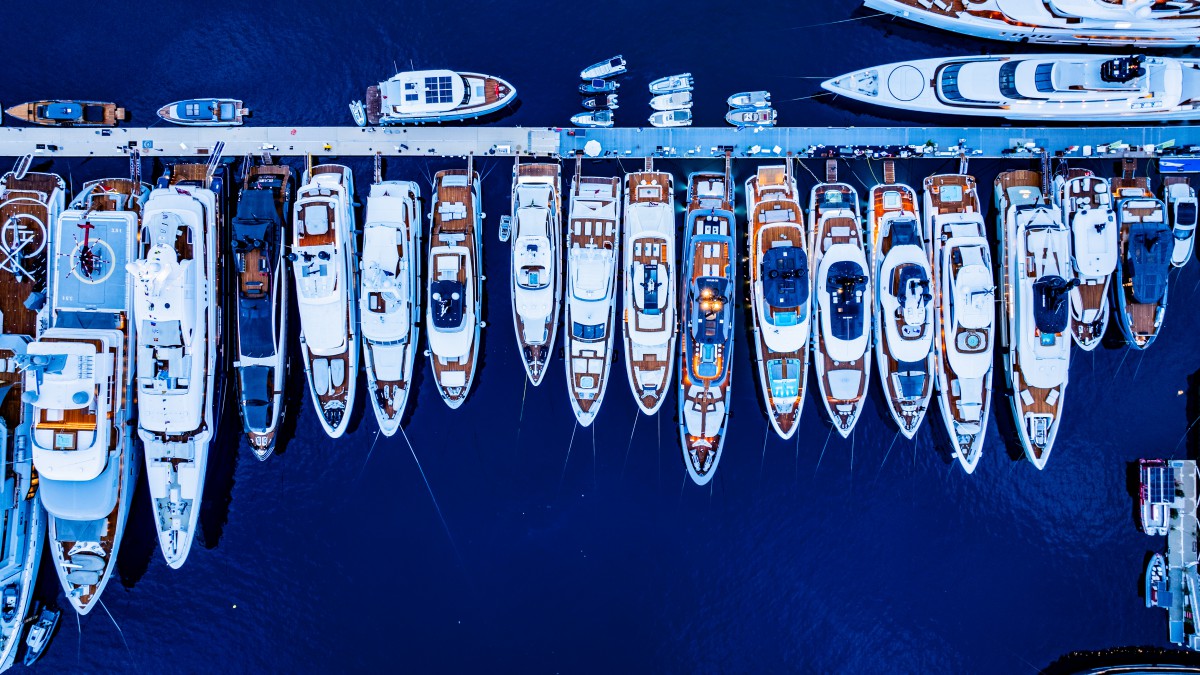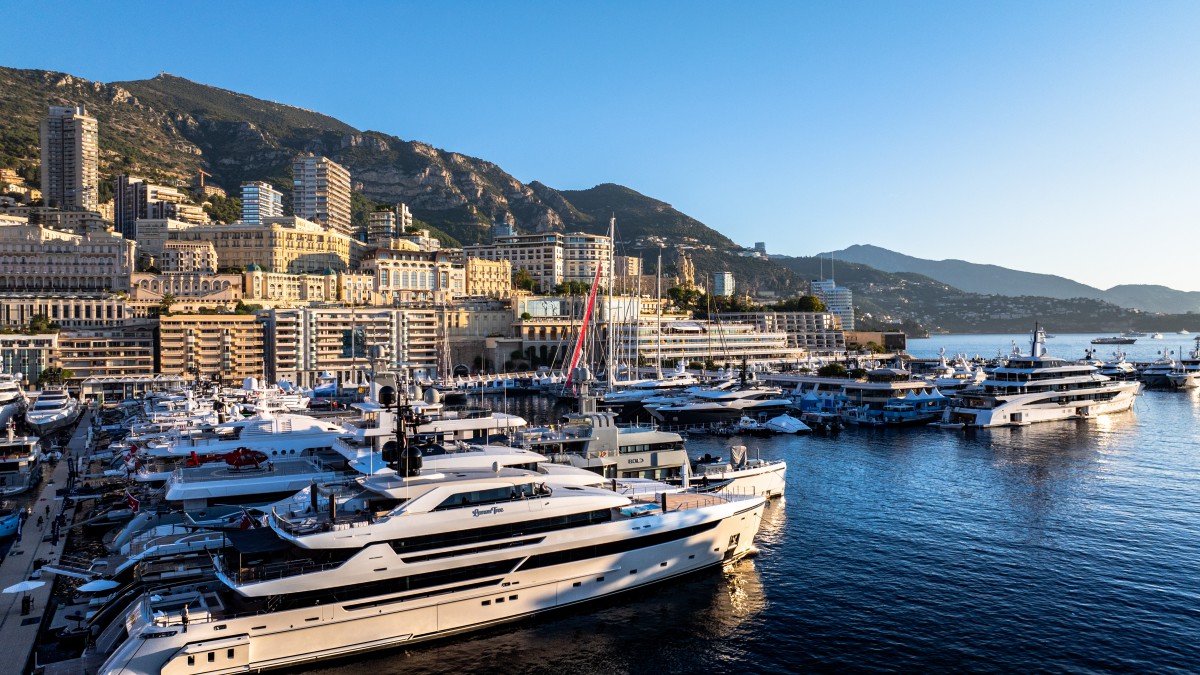A view from Port Hercule
We sit down with Gaëlle Tallarida, MD of The Monaco Yacht Show, to uncover what goes into making the crown jewel event of the yachting calendar…

There’s a distinguishable buzz in the air the moment you arrive in Monte Carlo during the last week of September. It is a humming sense of anticipation akin to the first day of a school trip as a child or returning to another semester at university. It’s the exciting mix of seeing old friends, making new ones, closing deals and traversing the battlefield of competitive business rivalries. And as the sun (usually) beams down on Port Hercule, glinting off the shiny hulls across the marina and you get a whiff of diesel in your lungs, you know that one of the busiest weeks of your year is about to begin.
But beneath the plethora of deck parties lies a meticulously crafted showcase 10 months in the making each year. One that has grown from modest beginnings to a globally renowned event. To understand more about its formation, history and intricacies, we speak with Gaëlle Tallarida, MD of The Monaco Yacht Show, to uncover what goes into making this superyacht spectacle not only the crown jewel of the yachting calendar but also a reflection of where the industry is headed next.
“The Monaco Yacht Show is undoubtedly the key rendezvous of the year for the entire yachting industry. It brings together all the major players, shipyards, brokers, designers and buyers, from around the globe,” explains Tallarida as she sips her coffee in the SuperyachtNews Lounge.
“I often describe it as an international marketplace, a central hub for the yachting world where innovations and new developments are showcased in one place. Many exhibitors specifically choose the Show as the platform to unveil their latest innovations. They may have already conducted sea trials throughout spring and summer, but Monaco is where these vessels truly make their grand debut. Some shipyards even include a clause in their contracts when building a yacht that reserves space at the Show for the official presentation.”
It's not just the show itself that necessarily draws people. Scenic beauty aside, Monaco offers unparalleled security and privacy for yachting professionals and guests alike. The city is a place where they can enjoy a few days of relaxation whilst paired with the mania that comes with frantically meeting with peers and business contacts in the industry across the city. But when you walk around Monte Carlo during the week of the show, you’ll see how the city’s hotels are full of visitors from all over the world who have come specifically for the event. The show is an incredible gathering, a global meeting point and an absolutely essential event for the yachting industry and it has woven itself into the national fabric.
“Before the show, I was speaking with someone from the government and they mentioned that yachting represents about 10% of Monaco's economic revenue,” explains Tallarida. “They also highlighted that over 3,000 people are employed in this local sector. The Monaco Yachting Cluster was established about ten years ago and there are now around 250 companies working directly in the yachting industry here in Monaco. But if you look at the broader region, the impact is even greater.”
Cote d’Azur is a natural home for yachting and while yachting might be relatively small in comparison to other sectors, it’s highly visible and influential here. Monaco, along with nearby areas like Saint-Tropez, Genoa and Cannes, is a favourite destination for yacht owners and guests during the summer months. The level of service and experiences offered in this region is exceptional, whether it’s golfing, dining at Michelin-star restaurants, or attending high-end cultural events, the area has an extraordinary density of world-class amenities.
The natural home for yachting accolades didn’t necessarily directly translate into the Monaco Yacht Show becoming a household name and the focal event of the industry in its early years, however. A local product herself, Tallarida grew up in Cap d'Ail and completed her studies in Monaco before joining the events team 25 years ago. For context, this is an era when 45-metre yachts were considered amongst the largest in the fleet. And back then, the event was quite small. In fact, during its first editions, MYS only had around 60 exhibitors. But by 2024, the exhibition has grown tenfold to about 600 exhibitors.
“When I first started, the Monaco Yacht Show wasn’t even seen as a major player,” recalls Tallarida. “I remember travelling to other shows like Düsseldorf in January and exhibitors would just brush me off. They didn’t want to exhibit at our show back then because we had only 60 exhibitors.”
“But after a few years, that completely changed. I started getting requests from the same companies to be part of the show and they were eager to participate. When I walked the aisles at other events, people would flood over to me and ask to be involved. And it is the work done by the people behind this show that has transformed it into something special. We've grown rapidly by focusing on the superyacht segment, which set us apart from other events.”
The Monaco Yacht Show is so much more than just a showcase; it is one of the few occasions where all yachting contributors can come together, a platform for the entire industry to come together. Other shows around the world don’t have quite the same scale in being superyacht-specific.
Take the Fort Lauderdale International Boat Show, for example. It’s very much focused on the US market and is not exclusively tailored for superyachts. But when you come to Monaco, it’s not just about the city or the region, it’s an international show and is entirely dedicated to the global superyacht market. Everything there from the yachts to the services and products caters to the superyacht industry specifically and that’s what has set the show apart through its evolution.
“Over the years, the show has evolved alongside the industry itself. But in the early days, it was quite different. When we first started, I remember how excited we were when a yacht over 40 metres appeared - it was considered exceptional. The industry was very artisanal, driven by small-scale craft activities and honestly, it wasn’t well-organised. There was no marketing, no websites, nothing to communicate what we were doing. It was very traditional, almost old-fashioned. The designs of yachts were simpler, even the windows were small and round, mostly due to the technological limitations of the time.”

One of the many things that makes this industry so fascinating is that it constantly evolves. We’ve gone from a somewhat traditional craft-based sector to one that’s incredibly forward-thinking. Yachting is often ahead of other industries in terms of technology, as we often see tech developed for yachts, whether for sustainability, propulsion, or onboard systems, start being adapted elsewhere and is largely driven by the demands of yacht owners, who are looking for the next big thing to enhance their vessels.
Over the past 25 years, Tallarida has seen tremendous investment from yacht owners, which she maintains has been the driving force behind the industry’s innovation. “The boundaries of technology have been pushed in every direction - not only in propulsion but also in the advanced remote systems that control every aspect of the yacht,” she continues.
“One of the most memorable yachts for me was the Maltese Falcon. It was the largest yacht I had ever seen at the time, and it really made an emotional impact on me. I believe it was around 2008 when the Maltese Falcon came to the show and it was truly cutting-edge with its joystick controls that could manage the entire sail system. At the time, that was revolutionary.”
More important for the MD of the show, however, is how they have had to adapt and evolve logistically. Setting up the Monaco Yacht Show is no easy feat and the challenges the team faces are extensive. Even though they don’t always highlight the logistical work that goes on behind the scenes, this is its primary focus.
“We work with key players in global event organisations, such as GL Events, who provide our tents and other infrastructure. Interestingly, they told us last year that the Show is the most complex event they handle worldwide. This is because it involves such a wide variety of materials and logistical requirements, far beyond what they typically offer at other events. Most shows take place in large exhibition halls where everything is contained within one space. But here, we must adapt to an entire city that is still functioning while we prepare for the show. People live here, they work here and we can't ask them to leave for weeks at a time.”
This makes the setup incredibly complicated, a process where Tallarida and her team must adjust their plans to accommodate the city, its residents and all the surrounding areas. People are going about their daily lives while the event is built around them. And to tackle this, Tallarida has developed a precise schedule working closely alongside the government. “But if anything goes wrong, such as several days of heavy rain, it can throw everything off,” adds Tallarida. “It’s a very stressful process because every year is a new challenge and we’re always racing against the clock.
“Fortunately, we’ve always managed to open the show on time, but it’s definitely challenging. This year, for example, our logistical team told me that we’ve reached the limits of what’s feasible in terms of the event’s setup. They even advised us not to sell any more space because we’re at capacity.”

Another challenge is keeping all the clients happy. As organisers, Tallarida always has to think about the broader picture, balancing the interests of visitors and exhibitors while also ensuring the show evolves to meet the latest trends, but it’s a complex task to satisfy everyone. “It’s completely logical that exhibitors have their interests, but very challenging to balance those with the general interests of the show as a whole,” she explains.
“In the past, we have had some exhibitors who felt we were being arrogant or uncooperative because we couldn’t always meet their specific requests for a certain stand. But that's not how we operate. I’ve always asked my team to explain our decisions, making it clear that they aren’t aimed against any one client. Our goal is to ensure that as many people as possible are satisfied with the show, because that’s what allows the event to continue successfully year after year, ensuring that it represents a true reflection of the industry, both in its diversity and scale.”
Fitting the yachting armada into the limited space is no simple task either. One of the most frequent and understandable requests from brokers and shipyards is to have their yachts positioned directly in front of their booth. While it makes sense from their perspective, it’s not always possible due to the size of the yacht or the available berths. And with so many yachts wanting to be featured, the organisers have to be strategic about using every inch of the venue.
For Tallarida, it’s all about optimising the space. For instance, a berth meant for a 100-metre yacht can’t be occupied by a 60-metre one, no matter what. Some clients can be quite insistent, but the organisers always strive to explain the logic behind these decisions, even if they can’t please everyone all at once. This careful balance is what has allowed the event to grow into what we see today. “Ultimately, we want to ensure that the show offers a great experience for visitors as well and that’s why we’re constantly working on refining the thematic elements of the event to enhance the overall visitor experience,” adds Tallarida.
“After COVID, we had an opportunity to reorganise things because the show was smaller in scale. We took advantage of that moment to move some companies around, even those that had been historically positioned in certain areas. Our goal was to create a dockside setup where only brokers, shipyards, management companies and designers were positioned near the yachts. This was done in response to exhibitor requests, aiming to create a more comfortable display area for VIPs, with only yacht-related companies in front of the yachts.”
No business can survive without its clients and the yacht show is no exception. Once the show is over, Tallarida immediately sits down with her team to reflect on how they can improve for the following year. Rather than repeating the same format, the MD must constantly think about how to innovate and present the industry in new ways that match the needs of both clients and exhibitors. And this changes year on year. One of the emerging trends, which has grown significantly over the past two years, is the increasing number of large catamarans. Naturally, multihulls take up more space, often requiring two berths instead of one, which complicates things for an event already popping at the seams.
“This is definitely going to be a bigger challenge for us since we don’t have much space left to accommodate them, so we need to decide how to manage this demand,” adds Tallarida. “It’s a trend we can’t ignore, though. We can’t simply say, ‘We don’t want them.’ We need to think about how to exhibit these larger vessels while optimising the space we have, whilst ensuring we don’t lose too much capacity.”
But it is the challenges and constant evolution of the show in tandem with the industry that drives Tallarida forward. And what makes the Monaco Yacht Show special, especially as a business platform, is the position it holds in the industry as it evolves in tandem. Tallarida is often asked if she is concerned about competition from other shows, but it is not something she indulges in. Her team simply focuses on how it can improve and with that comes immense pressure.
“Of course, this is not always easy to execute with a team of just 20 people, but we are incredibly dedicated. I’m very lucky to work with a passionate team,” adds Tallarida.
“You can’t work in event organisation if you aren’t passionate about it. It’s too challenging otherwise. The lead-up to September is especially intense. The pressure from the industry can be immense and it’s a demanding sector. But after 25 years of working in yachting and dedicating my life to this event, I don’t take the criticism personally. We spend ten months of the year preparing for the show, so it’s almost like delivering a baby. My family comes first, of course, but the Monaco Yacht Show is almost like my third child.”
“People who aren’t involved in yachting often ask me, ‘How do you still enjoy doing the same thing year after year?’ But what they don’t realise is that it’s never the same. Every year is different. There’s so much innovation happening in yachting. Sure, the logistics remain challenging, but the industry is always evolving and that’s what keeps it exciting.”
Profile links
NEW: Sign up for SuperyachtNewsweek!
Get the latest weekly news, in-depth reports, intelligence, and strategic insights, delivered directly from The Superyacht Group's editors and market analysts.
Stay at the forefront of the superyacht industry with SuperyachtNewsweek
Click here to become part of The Superyacht Group community, and join us in our mission to make this industry accessible to all, and prosperous for the long-term. We are offering access to the superyacht industry’s most comprehensive and longstanding archive of business-critical information, as well as a comprehensive, real-time superyacht fleet database, for just £10 per month, because we are One Industry with One Mission. Sign up here.
NEW: Sign up for
SuperyachtNewsweek!
Get the latest weekly news, in-depth reports, intelligence, and strategic insights, delivered directly from The Superyacht Group's editors and market analysts.
Stay at the forefront of the superyacht industry with SuperyachtNewsweek



